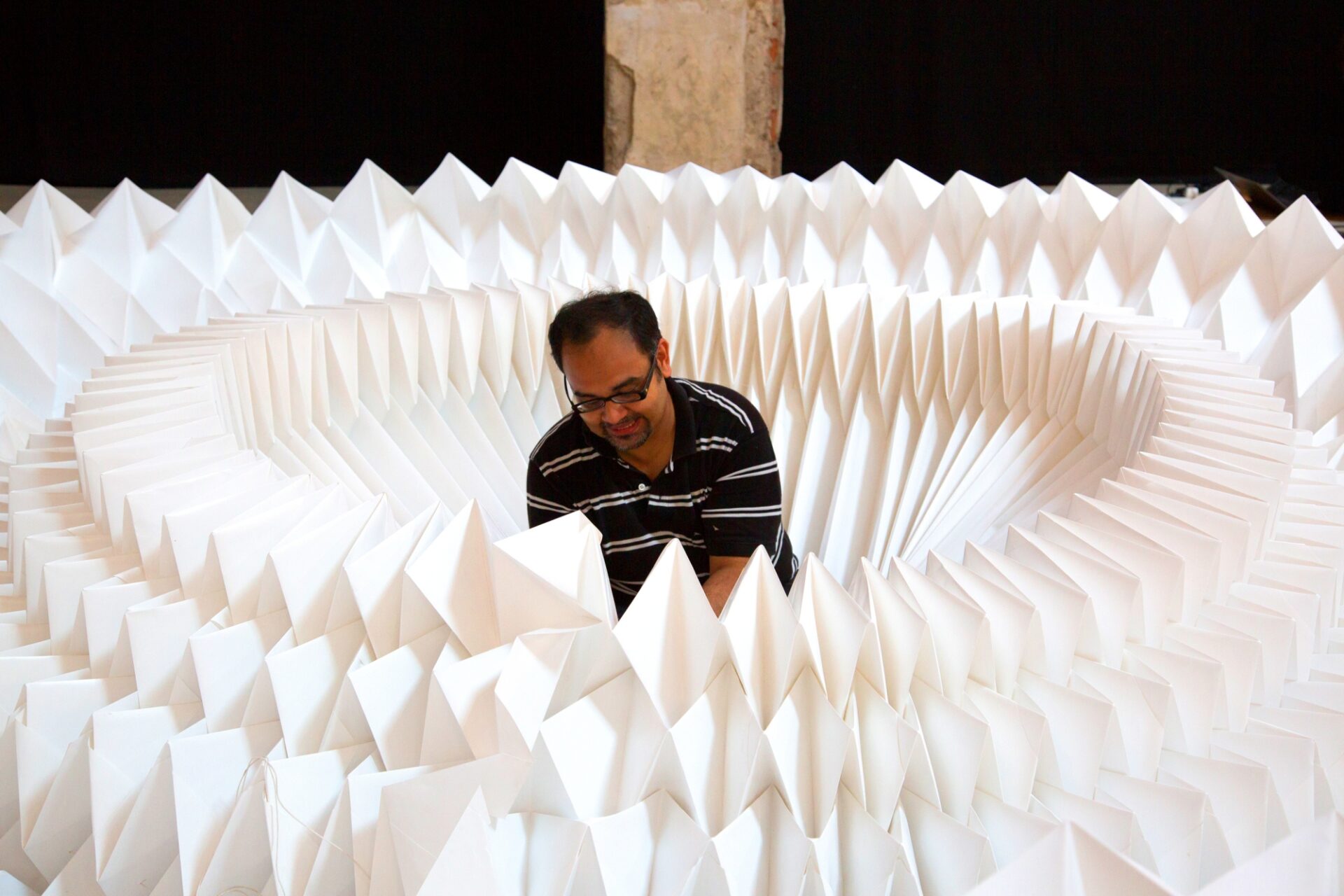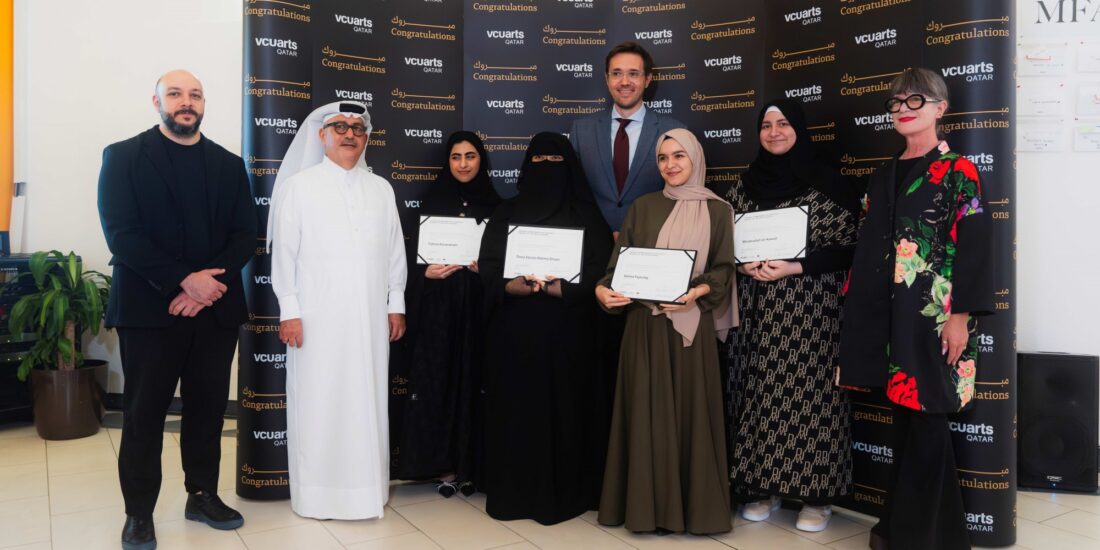The Art of Folding Forms
Ankon Mitra is a trained architect who practices as a landscape designer and a sculptor/installation artist in Delhi, India. He has built an international reputation as a pioneer of the folding technique and has had his work exhibited in India, Italy, France, the UK, the USA, Japan, China, Singapore, Brazil, The Maldives, and The Netherlands. By Amrita Shah

“Folding helps Mother Nature optimise processes, save energy, make flexible solutions, and strengthen weak materials,” says Ankon Mitra.
Oritecture is a word coined by architect, landscape designer, and sculptor Ankon Mitra and the name of his unique design practice ‘Oritecture – The Folding Studio & Workshop’. A delightful combination of ‘origami’ and ‘architecture’, the term is the most apt description of his passion for working with folded materials and developing a new design sensibility. Mitra is most recognised as an artist/sculptor who works with folded materials, and installations and 3-D artworks produced by the studio have been exhibited. He works across other disciplines too – as an architect and landscape designer. Boundaries often blur and it is not surprising that as a landscape designer, he treats the terrain as a large canvas for artistic intervention. Here, the folds he loves to work with are seen in the way water moves across a surface, or in a stepped garden.

Bells of Light ; Sometimes we can see sounds and sometimes we can hear the lights. In this work, three elliptical ‘bells’ of crystalline Kirigami fretwork create the sounds of a cathedral of light. This work by Mitra is at Gallery Art Motif.
Mitra was drawn to folding techniques while tackling his Master’s thesis at The Bartlett School of Architecture, University College London. Intent on creating a retractable roof for an airport, he gravitated toward an origami-like solution where the roof would fold away to open parts of the airport to the sky.
He reveals, “As I started making architectural models to implement the idea, I realised there is folding within and all around us — from our eyelids, brains, digestive tracts to all our fingers and limbs; to the movement of rivers; the branching of trees; the opening of leaf and flower buds; the umbrellas we use. Folding helps Mother Nature to optimise processes, save energy, make flexible solutions, and make weak materials stronger.”

Mitra with his work Ajrakh / Daabu, Ikat, and Baatik; fabrics pleated and folded into spiralling mandalas with hand-painted Jaipur blue tiles forming the nuclei of the mandalas.
Intent on understanding folding better as an engineer and researcher, origami simply became an extension of Mitra’s daily practice to learn more. The ‘art’ thus created was simply a by-product stemming from this curiosity.
Using paper on an architectural scale was not unheard of when Mitra ventured into it – Shigeru Ban had made houses out of paper – but it was relatively new ground in India and Europe. Mitra loved the idea of creating complex solutions from a few simple folds; weak materials were strengthened by folding; flexible systems could be created that could be reconfigured easily.
“In time I realised any sheet material can be folded with a little bit of coaxing. The studio has folded close to 75 different kinds of materials in the last 16 years – paper, plastics, leather, fabric, steel, brass, copper, aluminium, silver, wood veneer, and cork…. They are not as easily folded as a sheet of paper, but conversations with the material yield beautiful answers which become dialogues between man and material,” expounds Mitra.
He goes on to explain how the studio has created structures using brittle and harder materials such as glass, stone, concrete, ceramics, and terracotta by creating a folded appearance using other techniques. The list of materials he has experimented with does not end there – the studio has worked with onion peel, banana peel, chocolate, discarded sanitary pads, dried leaves, flower petals, and even cow dung!
As with any design, the creative process starts with a sketch or more likely a paper model in the studio. Mitra explains, “To think in three dimensions, our sketches must also be things which we can see from all directions. The information is then transferred to a computer and after a lot of back and forth, the outcome emerges. Materials don’t always behave as the computer predicts, so we make partial full-scale sampling of the works.”

Lilium Chandeliers in collaboration with Studio Lotus for “Cousu d’Or” an Indo-French fashion exhibition by Ekaya, Banaras.
As an architect with the soul of an artist, Mitra’s approach to a problem is best described in an example he often cites to his clients: “An architect designs a space and then buys a beautiful chandelier to light it up and to act as a piece of art. Most people see the ceiling and the chandelier as two separate things. Why can’t these be integrated into one? Why can’t the ceiling itself be a work of art and a source of light?”
Mitra calls himself an architect’s artist in that he understands the constraints an architect must work within, and is able to create an intervention within those boundaries. He jokes – architects find his work ‘decorative’, while artists find it ‘rather mathematical’.
Not all the work produced by the studio is purely aesthetic in nature. The studio has devised innovative ways to use paper folding techniques to solve problems. A ‘folding’ baby box was developed for construction workers who needed a safe space to house their infants on construction sites. They also designed a folded torus-shaped HEPA filter for an Indian start-up that wanted to manufacture cylindrical air-conditioners. Mitra says, “Folding solutions find applications across disciplines from robotics to deployable solar panels in space. Artists must be at the forefront of innovation for the future. Being an artist who is perhaps not really an artist at all is exciting to me. Why wear only one thinking hat when I can wear six?” Why indeed?
Photographs courtesy Ankon Mitra
Ankon Mitra is Director (Landscape) at Hexagramm Design PL and his extensive folding practice evolved from his professional work in landscape art and architecture. He teaches the aesthetic, material, technical and structural aspects of folding at IITs, NIDs and other colleges of art, architecture and engineering in India, S-E Asia and the Middle-East. He also teaches Landscape Ecology and Permaculture to Anant Fellowship students at the Anant National University, Ahmedabad as a visiting faculty.









